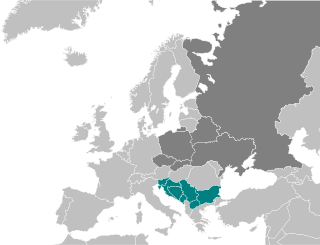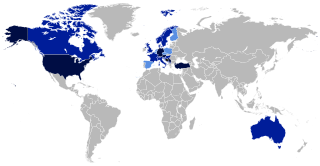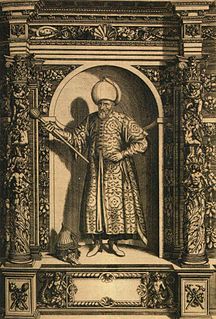
This article is about the demographic features of the population of Bosnia and Herzegovina, including population density, ethnicity, education level, health of the populace, economic status, religious affiliations and other aspects of the population.

Slavs are an ethno-linguistic group of people who speak the various Slavic languages of the larger Balto-Slavic linguistic group of the Indo-European languages. They are native to Eurasia, stretching from Central, Southeastern and Eastern Europe, all the way north and eastwards to Northeast Europe, Northern Asia, and Central Asia, as well as historically in Western Europe and Western Asia. From the early 6th century they spread to inhabit most of Central, Eastern and Southeastern Europe. Today, there is a large Slavic diaspora throughout the Americas, particularly in the United States, Canada, Brazil and Argentina as a result of immigration.

The Party of Democratic Action is a Bosniak nationalist, islamist, conservative political party in Bosnia and Herzegovina.

More than 96% of population of Bosnia and Herzegovina belongs to one of its three autochthonous constituent peoples: Bosniaks, Serbs and Croats. The term constituent refers to the fact that these three ethnic groups are explicitly mentioned in the constitution, and that none of them can be considered a minority or immigrant. The most easily recognizable feature that distinguishes the three ethnic groups is their religion, with Bosniaks predominantly Muslim, Serbs predominantly Orthodox Christians, and Croats Catholic.
Muslims as a designation for a particular ethnic group, refers to one of six officially recognized constituent peoples of Socialist Federal Republic of Yugoslavia. The term was adopted in 1971, as an official designation of ethnicity for Yugoslav Slavic Muslims, thus grouping together a number of distinct South Slavic communities of Islamic ethnocultural tradition, among them most numerous being the modern Bosniaks of Bosnia and Herzegovina, along with some smaller groups of different ethnicity, such as Gorani and Torbeši. This designation did not include Yugoslav non-Slavic Muslims, such as Albanians, Turks and Romani.

Islam is one of the two main religions practised in Bosnia and Herzegovina, the other one being Christianity. It was introduced to the local population in the 15th and 16th centuries as a result of the Ottoman conquest of Bosnia and Herzegovina.

The South Slavs are a subgroup of Slavic peoples who speak the South Slavic languages. They inhabit a contiguous region in the Balkan Peninsula and the eastern Alps, and in the modern era are geographically separated from the body of West Slavic and East Slavic people by the Romanians, Hungarians, and Austrians in between, or geographically the Black Sea. The South Slavs today include the nations of Bosniaks, Bulgarians, Croats, Macedonians, Montenegrins, Serbs and Slovenes. They are the main population of the Southeastern European countries of Bosnia and Herzegovina, Bulgaria, Croatia, Montenegro, North Macedonia, Serbia and Slovenia.

Islam is the second-largest religion in Europe after Christianity. Although the majority of Muslim communities in Western Europe formed recently, there are centuries-old Muslim societies in the Balkans, Southeastern Europe, Caucasus, Crimea, and Volga region, such as Slavic Muslims, Muslim populations of Albanians, Greeks, Romani, Balkan Turks, Pomaks, Bosniaks, Yörüks, Volga Tatars, Crimean Tatars, and Megleno-Romanians from Notia today living in Turkey. The term "Muslim Europe" is used to refer to the Muslim-majority countries in the Balkans and parts of countries in Eastern Europe with sizable Muslim minorities that constitute large populations of native European Muslims, although the majority are secular.
Bosniaks are a South Slavic ethnic group, native to Bosnia and Herzegovina and the region of Sandžak. The term Bosniaks was re-instated in 1993 after decades of suppression in the Socialist Federal Republic of Yugoslavia. The Bosniak Assembly adopted the ethnonym to replace "Bosnian Muslims." Scholars believe that the move was partly motivated by a desire to distinguish the Bosniaks from the fabricated and imposed term Muslim to describe their nationality in the former Yugoslavia. These scholars contend that the Bosniaks are distinguishable from comparable groups due to a collective identity based on a shared environment, cultural practices and experiences.

The Party for Democratic Action or Democratic Action Party is a political party in Serbia, representing the Albanian ethnic minority and is currently led by Shaip Kamberi.

European Islam is a hypothesized new branch of Islam that historically originated and developed among the indigenous White European peoples of the Balkans and Southeastern Europe: Bosnia and Herzegovina, Albania, Kosovo, Montenegro, Bulgaria, North Macedonia, and some republics of Russia, which constitute of large populations of native White European Slavic Muslims, alongside Muslim populations of Albanians, Greeks, Romani, Balkan Turks, Pomaks, Yörüks, Volga Tatars, Crimean Tatars, and Megleno-Romanians from Notia today living in Turkey, although the majority are secular.

Bosniaks or Bosniacs are a South Slavic ethnic group native to the Southeast European historical region of Bosnia, which is today part of Bosnia and Herzegovina.

Mehmed Handžić was a Bosnian Islamic scholar, theologian and politician. Handžić was the leader of the Islamic revivalist movement in Bosnia and the founder of the religious association El-Hidaje. He was one of the authors of the Resolution of Sarajevo Muslims and the chairman of the Committee of National Salvation.
Bosnians are people identified with the country of Bosnia and Herzegovina or with the region of Bosnia. As a common demonym, the term Bosnians refers to all inhabitants/citizens of the country, regardless of any ethnic, cultural or religious affiliation. It can also be used as a designation for anyone who is descended from the region of Bosnia. Also, a Bosnian can be anyone who holds citizenship of the state of Bosnia and Herzegovina and thus is largely synonymous with the all-encompassing national demonym Bosnians and Herzegovinians. This includes, but is not limited to, members of the constituent ethnic groups of Bosnia and Herzegovina: Bosniaks, Serbs, and Croats. Those who reside in the smaller geographical region of Herzegovina usually prefer to identify as Herzegovinians.
The Balkan Turks or Rumelian Turks are the Turkish people who have been living in the Balkans since the Ottoman rule as well as their descendants who still live in the region today. The Turks are officially recognized as a minority in Bosnia and Herzegovina, Bulgaria, Croatia, Kosovo, North Macedonia, and Romania; in Greece the Turkish speaking minority is recognized as "Greek Muslims". Furthermore, the Turkish language has minority language status in Bosnia and Herzegovina, North Macedonia, and Romania. The Ottoman Empire conquered parts of the Balkans between the 14th and 16th century.
Croat Muslims are Muslims of Croat ethnic origin. They consist primarily of the descendants of the Ottoman-era Croats.
Vlachs was a social and fiscal class in several late medieval states of Southeastern Europe, and also a distinctive social and fiscal class within the millet system of the Ottoman Empire, composed largely of Eastern Orthodox Christians who practiced nomadic and semi-nomadic pastoral lifestyle, including populations in various migratory regions, mainly composed of ethnic Vlachs, Serbs and Albanians. From the middle decades of the 17th century the amalgamation of the process of sedentarization of the Orthodox Vlachs and their gradual fusion with Serbian rural population reached a high level and was officially recognized by the Ottoman authorities.

Serb Muslims or Serb Mohammedans are ethnic Serbs who are Muslims by their religious affiliation.

The North Slavs are a subgroup of Slavic peoples who speak the North Slavonic languages, a classification which is not universally accepted although it has been in use for several centuries. They separated from the common Slavic group in the 7th century CE, and established independent polities in Central and Eastern Europe by the 8th and 9th centuries.
Bosniakisation designates the process of ethnic and cultural assimilation of non-Bosniak individuals or groups into the Bosniak ethnocultural corpus. Historically, bosniakisation was directed mainly towards some other South Slavic groups, like ethnic Muslims (Muslimani) in former Yugoslavia. Since most Bosniaks in todays time are Sunni Muslims.













